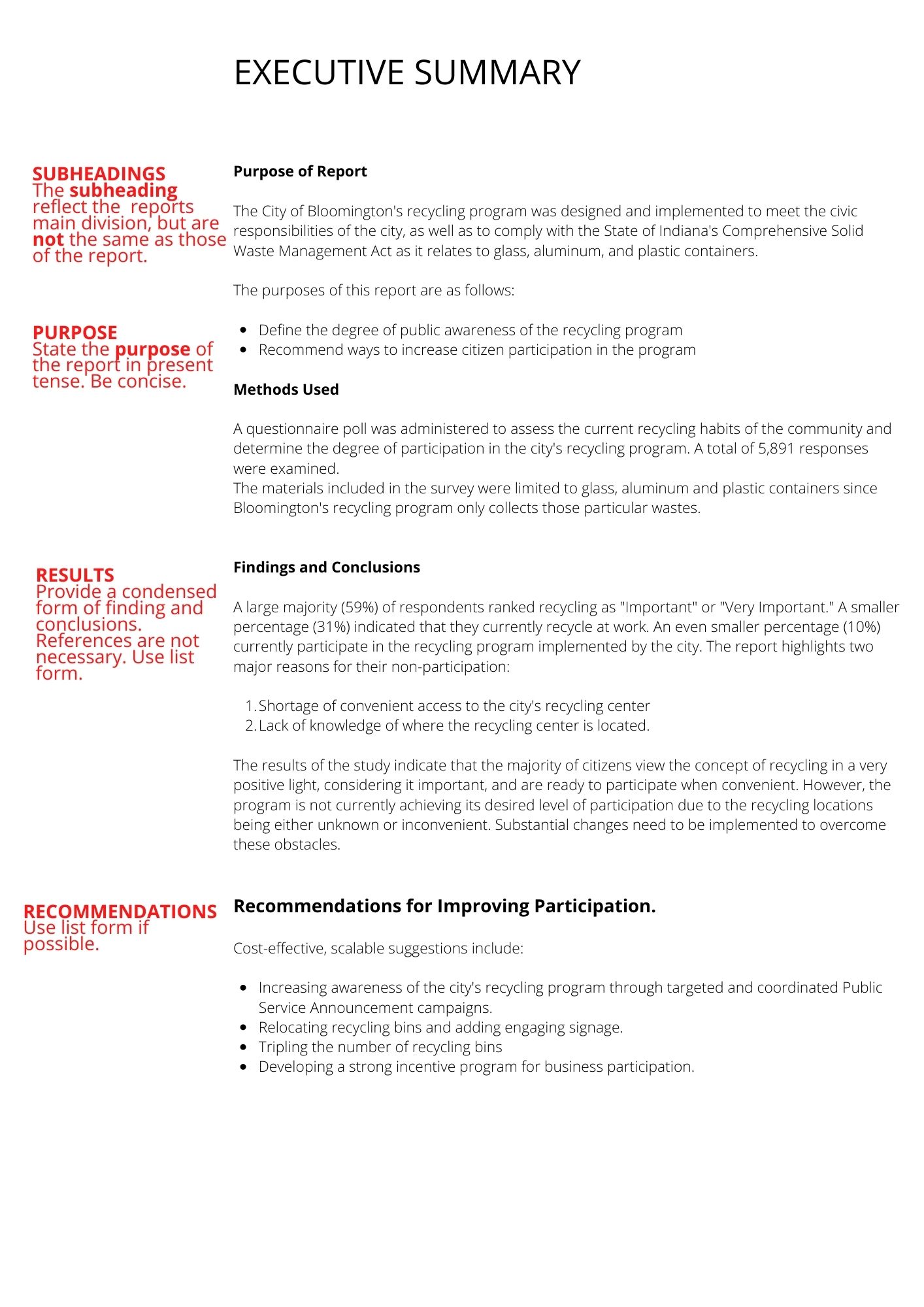Whether you work in banking, real estate, insurance, manufacturing, law, education, or another profession, you’ve likely had or will have to write an executive summary. In this article, we’ll discuss tips for writing relevant and useful executive summaries.
Let’s dive in!
What is an Executive Summary?
An executive summary is a concise summary of a longer document or proposal, intended to give readers an understanding of the main points without having to read the entire document. It’s an important tool in business and academic settings, used in reports, business plans, research papers, marketing proposals, and more.
Executive summaries are not background and not an introduction. People who read only the executive summary should get the essence of the document without fine details.
What Should be Included in an Executive Summary?
An executive summary should be tailored based on the document’s content and intended audience. Components of an executive summary may include:
Introduction: Begin with an introduction that provides context about the document or project. This could be a brief description of the company, project, or proposal the summary is derived from.
Example: “XYZ Corporation, established in 2010, is a leading provider of sustainable energy solutions targeting mid-sized industries.”
Project or Business Summary: Clearly state the objective or mission of the business or project. This should succinctly convey the main goal or purpose.
Example: “Our new project, ‘Green Future’, aims to revolutionize the energy sector by providing affordable, efficient, and eco-friendly energy solutions to 50 industries within the next three years.”
Problems and Solutions: Highlight the primary challenges or problems addressed in the document and outline the proposed solutions or strategies to overcome them.
Example: “The industrial sector contributes to 40% of global carbon emissions. ‘Green Future’ proposes to reduce these emissions by 20% by integrating solar and wind energy sources.”
Background Information: Offer relevant background details that can help the reader understand the context, such as the history of the project or the motivation behind a business idea.
Example: “Over the past five years, XYZ Corporation has collaborated with top energy researchers to devise a hybrid energy model that is both sustainable and efficient.”
Market Research and Competitive Advantage: Summarize market research findings, emphasizing what sets your product, service, or project apart from competitors.
Example: “Our market analysis indicates a 25% increase in demand for sustainable energy in the next decade. Unlike our competitors, our patented energy conversion technique ensures a 95% efficiency rate.”
Business Model: Briefly explain the business model or strategy that will be used to achieve the objectives stated earlier.
Example: “We operate on a subscription-based model, allowing industries to receive continuous energy updates and maintenance services for a fixed monthly fee.”
Key Findings or Results: If applicable, present any significant findings or results derived from the main document, especially if they validate the approach or solution proposed.
Example: “Pilot testing in five industries resulted in a 15% reduction in energy costs and a 10% decrease in carbon footprints within a year.”
Conclusions or Recommendations: Depending on the nature of the main document, wrap up the summary with conclusions drawn from the data or any recommendations for future actions.
Example: “To achieve a greener industrial future and meet global carbon reduction targets, adopting the ‘Green Future’ model is not only beneficial but essential.”
As for length, while there’s no strict word count, the summary should be concise enough to be skimmed in a few minutes but detailed enough to deliver the main points. Typically, it should be about 5-10% of the length of the original document, ensuring it doesn’t overwhelm the reader with too many details.
Tone and Language in an Executive Summary
Tone and language can have a meaningful impact on how your summary, or any written communication, is received. Some things to keep in mind:
- True to Your Company and Audience: Tailor the tone of your executive summary to reflect your company’s culture and the intended audience. For instance, if you are a startup addressing young entrepreneurs, a slightly informal and energetic tone might be appropriate. Conversely, a report for corporate stakeholders should be more traditional and formal.
- Balanced: While it’s essential to be optimistic and highlight the positive aspects, avoid overselling or making unsupported claims. Strive for a balanced perspective that gives an honest and realistic view of the situation or proposal.
- Clear and Understandable: Not all readers might be experts in the field. Avoid technical terms or industry jargon unless necessary and, if used, provide brief explanations. The language should be simple, straightforward, and free from ambiguity.
- Engaging: While brevity and clarity are essential, it’s also important to engage the reader. Start with a strong opening statement that captures attention, and use persuasive language to emphasize the importance and relevance of the content.
Tips for Writing an Executive Summary
- Identify the Problem or Need: Before diving into the solution, clearly articulate the problem or need your project or proposal addresses. This sets the context and justifies why your solution is necessary.
- Keep it Concise: The executive summary should be a standalone piece that summarizes the key points. It should provide brief context about the document or project but should not repeat the background or introduction sections. Avoid directly copying content from the body of the document into the executive summary.
- Prioritize Key Points: Focus on the most vital aspects of your report or business plan. It’s about selecting the most impactful information that will drive your primary message home.
- Use a Logical Structure: Organize your summary in a manner that flows logically. Begin with the problem, followed by the solution and benefits, and end with expected results or a call to action.
- Engage Your Reader: Use persuasive and clear language. Your goal is to convince stakeholders, so your tone should be confident and authoritative.
- Don’t Overuse Jargon: While some technical terms might be necessary, overloading your summary with jargon can alienate readers who might not be familiar with specific industry terms.
- Align Content: Whatever the executive summary highlights must be included in the report. Likewise, the report should not contain major points that did not appear in the summary.
- Call to Action: Don’t forget to include a compelling call to action if you’re presenting a proposal or solution. This is where you encourage the reader to take the next steps, be it funding your project or approving your proposal.
Examples
Fictional Example 1: Here is a fictional summary of a proposal on sustainable housing design.
Executive Summary
Purpose of Report
GreenTech Innovations, a pioneer in sustainable technology, is excited to present a proposal for its latest project, “Eco-Safe Homes”. This proposal aims to revolutionize the housing sector by integrating eco-friendly technology into the architectural designs of residential homes.
The current housing market often overlooks sustainability in favor of short-term profits. This leads to wasted energy, higher bills for homeowners, and increased carbon footprints. Our mission is to create residential spaces that not only serve as comfortable homes but also contribute positively to the environment.
Greentech Innovations’ architectural designs use solar energy, rainwater harvesting, and other sustainable technologies to combat these challenges. We plan to collaborate with real estate developers and offer them our sustainable designs.
Findings and Conclusions
Our research indicates a growing demand among consumers for sustainable housing options. Unlike our competitors, who often integrate just one or two green features, our designs encompass a holistic approach, making them both eco-friendly and cost-efficient in the long run.
Pilot projects have shown a 60% reduction in energy bills for homeowners and a 40% decrease in carbon emissions compared to traditional homes. Furthermore, 85% of our surveyed customers expressed higher satisfaction living in an “Eco-Safe Home”.
Recommendations
We recommend real estate stakeholders to adopt and invest in our sustainable designs. By doing so, not only will they cater to a growing market demand but also play a pivotal role in driving the change towards a sustainable future.
Fictional Example 2: Here is a fictional, one-page summary of a report on the participation in the newly-implemented recycling program by the city of Bloomington, IN.

Helpful Resources
Other helpful resources on writing executive summaries:
- How to Write an Executive Summary in 10 Steps
- How to Write an Executive Summary (with examples)
- How to Write an Executive Summary: 8 Executive Summary Tips






